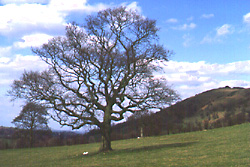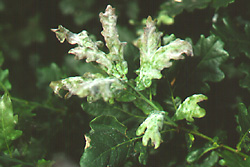by Avice Hall, University of Hertfordshire, UK

In the UK there are two species of deciduous oak,
Quercus robur and
Quercus petraea. The two species have a slightly different but overlapping distribution. Both are wind pollinated trees and there is great potential for the production of fertile hybrids. Oaks are said to have more species of plant, animals and microorganisms associated with them than any other species in Britain, thus they almost form an ecosytem in their own right.

From June each year, there is infection
of young leaves by oak powdery mildew,
Microspheara alphitoides. However
,
Q. robur is more susceptible than
Q. petraea and hybrids show intermediate
susceptibility.
© P. Beales 1997
This disease illustrates well some of the characteristics of plant diseases in natural communities where man has little influence. It gives a hint of the roles that plant pathogens play in ecosystems, and why there needs to be a Biodiversity Action Plan to conserve even these disease causing organisms.
1) One species is more susceptible than the other.
2) Whilst many individual leaves on a tree may be infected and die, M. alphitoides alone is rarely a cause of tree death.
3) The hybrids show a complete range of susceptibility.
 4) When hybrid acorns germinate they often form a monoculture of seedling oaks near the parent tree. Some become heavily diseased and die, whilst others (presumably with more resistance characteristics) live and grow to maturity.
4) When hybrid acorns germinate they often form a monoculture of seedling oaks near the parent tree. Some become heavily diseased and die, whilst others (presumably with more resistance characteristics) live and grow to maturity.
5) Oak powdery mildew and its hosts are a good example of how hosts and pathogens can co-evolve over many millenia and remain in balance provided that there is an absence of interference from man.
Conservation of host and pathogen are necessary to preserve the total ecosystem. To eradicate the pathogen would lead to a series of unpredictable changes in the evolution of oaks and their ecosystem.
RETURN TO APSnet FEATURE STORY
